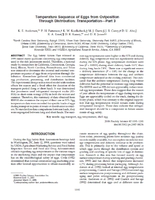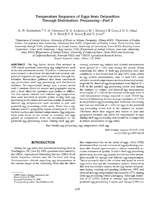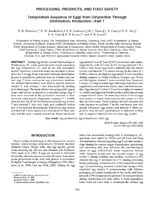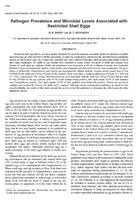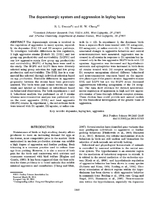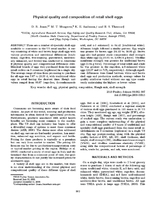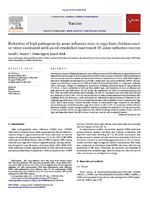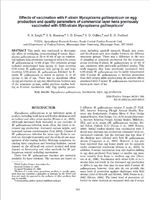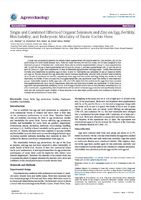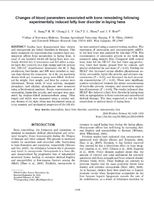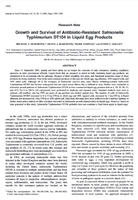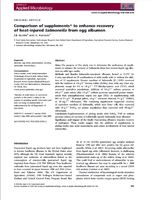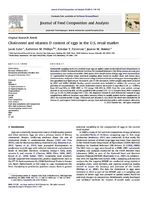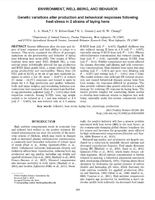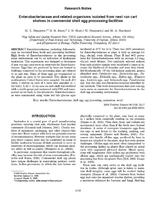Items tagged "egg production": 44
Temperature Sequence of Eggs from Oviposition Through Distribution: Transportation--Part 3
The Egg Safety Action Plan released in 1999 raised many questions concerning egg temperature used in the risk assessment model. Therefore, a national study by researchers in California, Connecticut, Georgia, Iowa, Illinois, North Carolina, Pennsylvania, and Texas was initiated to determine the internal and external temperature sequence of eggs from…
Temperature Sequence of Eggs from Oviposition Through Distribution: Processing--Part 2
The Egg Safety Action Plan released in 1999 raised questions concerning egg temperature used in the risk assessment model. Therefore, a national study was initiated to determine the internal and external temperature sequence of eggs from oviposition through distribution. Researchers gathered data from commercial egg production, shell egg…
Temperature Sequence of Eggs from Oviposition Through Distribution: Production--Part 1
During Egg Safety Action Plan hearings in Washington, DC, many questions were raised concerning the egg temperature (T) used in the risk assessment model. Therefore, a national study was initiated to determine the T of eggs from oviposition through distribution. In part 1; researchers gathered data on internal and surface egg T from commercial…
Pathogen prevalence and microbial levels associated with restricted shell eggs
Restricted shell eggs that do not meet quality standards for retail but maintain acceptable quality for inclusion in further processed eggs are often diverted to further processing. A study was conducted to characterize the microbiological populations present on and in these eggs. On a single day, restricted eggs were collected from three shell egg…
The dopaminergic system and aggression in laying hens
The dopaminergic system is involved in the regulation of aggression in many species, especially via dopamine (DA) D1 and D2 receptor pathways. To investigate heritable differences in this regulation, 2 high aggressive strains [Dekalb XL (DXL) and low group egg productivity and survivability (LGPS)] and one low aggressive strain (low group egg…
Physical quality and composition of retail shell eggs
There are a number of specialty shell eggs available to consumers in the US retail market. A survey consisting of white and brown large shell eggs with various production and nutritional differences (traditional, cage-free, free-roaming, pasteurized, nutritionally enhanced, and fertile) was conducted to determine if physical quality and…
Short preincubations during egg storage increases hatchability and chick quality in long-stored broiler eggs
It is recognized that cool egg storage for 8 d or longer, commonly employed in broiler parent and commercial layer production, reduces hatchability. In this study, we investigated the efficacy of short periods of incubation during egg storage (SPIDES) in the restoration of hatchability of broiler hatching eggs stored for 21 d. Prolonged cool…
Reduction of high pathogenicity avian influenza virus in eggs from chickens once or twice vaccinated with an oil-emulsified inactivated H5 avian influenza vaccine
The negative impact of high pathogenicity avian influenza virus (HPAIV) infection on egg production and deposition of virus in eggs, as well as any protective effect of vaccination, is unknown. Individually housed non-vaccinated, sham-vaccinated and inactivated H5N9 vaccinated once or twice adult White leghorn hens were challenged…
Effects of vaccination with F-strain Mycoplasma gallisepticum on egg production and quality parameters of commercial layer hens previously vaccinated with 6/85-strain Mycoplasma gallisepticum
This study was conducted to determine the effect of overlaying (revaccinating) F-strain Mycoplasma gallisepticum at 22 or 45 wk of age on commercial leghorn hens previously vaccinated with 6/85-strain M. gallisepticum at 10 wk of age. The treatment groups included unvaccinated hens (group 1), hens receiving 6/85-strain M. gallisepticum only (group…
Single and combined effects of organic selenium and zinc on egg, fertility, hatchability, and embryonic mortality of exotic cochin hens
A study was conducted to examine the effects of diets supplemented with organic selenium, (Se) and zinc, (Zn) on the performance of Cochin exotic breeder hens. Forty-two week old hens (n=120) and males (n=12) were assigned to four treatment groups of 10 females and 1 male each. Birds with no mineral supplementation (Group 1); feed supplemented with…
Changes of blood parameters associated with bone remodeling following experimentally induced fatty liver disorder in laying hens
Studies have demonstrated that obesity and osteoporosis are linked disorders in humans. This study examined the hypothesis that excessive lipid consumption affects bone metabolism in laying hens. A total of one hundred 63-wk-old laying hens were randomly divided into 2 treatments and fed either a regular layer diet (control) or a high energy and…
Growth and Survival of Antibiotic-Resistant Salmonella Typhimurium DT104 in Liquid Egg Products
Since 11 September 2001, quality and food safety are no longer the concerns of only consumers, industry, regulatory agencies, or other government officials. Liquid foods that are prepared or stored in bulk, including liquid egg products, are considered to be at potential risk for sabotage. Because of their versatility, low price, and functional…
Comparison of supplements to enhance recovery of heat-injured Salmonella from egg albumen
The purpose of this study was to determine the proficiency of supplements to enhance the recovery of Salmonella from heat-treated liquid egg albumen on solid agar media. Salmonella-inoculated albumen, heated at 53·3°C for 4 min, was plated on 39 combinations of solid media with or without the addition of 12 supplements. Greater numbers of…
A federal and state transport plan for movement of eggs and egg products from commercial egg production premises in a high-pathogenicity avian influenza control area
The FAST Eggs Plan is a voluntary plan for commercial egg producers intended to facilitate business continuity following an outbreak of HPAI. Participation in the FAST Eggs Plan will reduce the time required for regulatory officials to determine that it is safe for eggs and egg products from noninfected chickens located within a control area to…
Cholesterol and vitamin D content of eggs in the U.S. retail market
Nationwide sampling in the U.S. of whole large eggs, to update values in the United States Department of Agriculture (USDA) National Nutrient Database for Standard Reference (SR) (http://www.ars.usda.gov/nutrientdata), was conducted in 2000–2001 and in 2010. Retail cartons of large eggs were obtained from 12 supermarket locations using statistical…
Genetic variations alter production and behavioral responses following heat stress in 2 strains of laying hens
Genetic differences alter the type and degree of hens’responses and their ability to adapt to a stressor. This study examined the effects of genotypic variations on the productivity and behavior of laying hens following heat stress (HS). Two strains of White Leghorn hens were used: DXL (Dekalb XL), a commercial strain individually selected for egg…
Egg Wash Wastewater: Estrogenic Risk or Environmental Asset?
Commercial production of eggs and egg products requires the washing of eggs to remove urinary / fecal material and broken egg residue. In the case of one Ohio farming facility, 1.6 million birds produce 1.4 million eggs per day, using ~50mL of wash water / egg or ~ 70,000 liters per day. The aqueous waste stream was evaluated for estrogenicity, to…
Development of Antimicrobial Coatings for Improving the Microbiological Safety and Quality of Shell Eggs
This study was conducted to develop antimicrobial coatings to decontaminate and prevent cross-contamination of shell eggs. Egg shells were inoculated with nalidixic acid resistant Salmonella enterica Enteritidis strains OB030832, OB040159, and C405, and then treated with antimicrobial coatings. Polylactic acid (PLA) served as a non-edible polymer…
Vitamins A, E and fatty acid composition of the eggs of caged hens and pastured hens
In the US farmers often market pastured poultry eggs for a premium price, claiming animal and human health benefits. We examined how moving pastured hens to forage legumes or mixed grasses influenced hen (Gallus gallus L.) egg omega-3 fatty acids and concentrations of vitamins A and E. We also compared the eggs of the pastured hens to those of hens…
Enterobacteriaceae and related organisms isolated from nest run cart shelves in commercial shell egg processing facilities
Enterobacteriaceae, including Salmonella, may be recovered from foods and processing facilities. High levels of Enterobacteriaceae in the processing plant environment can be an indication of inadequate sanitation. This experiment was designed to determine if nest run egg carts serve as reservoirs for Enterobacteriaceae. Eggs that are produced by…
 An official website of the United States government.
An official website of the United States government.


